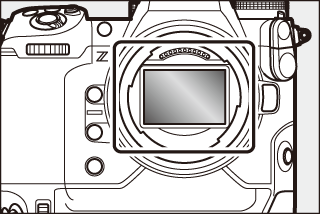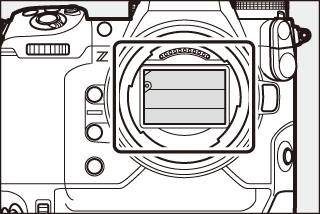Caring for the Camera and Battery: Cautions
- Cautions: Using the Camera
- Cautions: Using Batteries
- Cautions: Using the Charger
- Cautions: Using the Charging AC Adapter
Cautions: Using the Camera
Do not drop the camera or lens or subject them to blows. The product may malfunction if subjected to strong shocks or vibration.
Keep the camera dry. Rusting of the internal mechanism caused by water inside the camera can not only be expensive to repair but can in fact cause irreparable damage.
Taking the camera from a warm to a cold environment or vice versa may cause damaging condensation inside and outside the camera. Place the camera in a sealed bag or plastic case before taking it across a temperature boundary. The camera can be taken from the bag or case once it has had time to adjust to the new temperature.
Static charges or the magnetic fields produced by equipment such as radio transmitters could interfere with the monitor, corrupt data stored on the memory card, or affect the product’s internal circuitry.
Do not leave the lens pointed at the sun or other strong light sources. Intense light may damage the image sensor or cause fading or “burn in”. Photographs taken with the camera may exhibit a white blur effect.
Data stored on the device could be corrupted.
Do not direct lasers or other extremely bright light sources toward the lens, as this could damage the camera’s image sensor.
When cleaning the camera body, use a blower to gently remove dust and lint, then wipe gently with a soft, dry cloth. After using the camera at the beach or seaside, wipe off any sand or salt using a cloth lightly dampened in fresh water and then dry the camera thoroughly. In rare instances, static electricity may cause the LCD displays to light up or go dark; this does not indicate a malfunction. The display will soon return to normal.
These glass elements are easily damaged: remove dust and lint with a blower. If using an aerosol blower, keep the can vertical to prevent the discharge of liquid that could damage glass elements. To remove fingerprints and other stains from the lens, apply a small amount of lens cleaner to a soft cloth and wipe the lens carefully.
Under no circumstances should you exert pressure on the image sensor, poke it with
cleaning tools, or subject it to powerful air currents from a blower. These actions
could scratch or otherwise damage the sensor.
For information on cleaning the image sensor, see “Image Sensor Cleaning” (Image Sensor Cleaning) and “Manual Cleaning” (Manual Cleaning).
If [] is selected for [] in the setup menu, the sensor shield in front of the image sensor will close when
the camera turns off. Never pierce or apply pressure to the sensor shield. Failure
to observe this precaution could scratch or otherwise damage the shield.
Keep the lens contacts clean. Avoid touching them with your fingers.
To prevent mold or mildew, store the camera in a dry, well-ventilated area. Do not store the camera with naphtha or camphor moth balls, next to equipment that produces strong electromagnetic fields, or where it will be exposed to extremely high temperatures, for example near a heater or in an enclosed vehicle on a hot day. Failure to observe these precautions could result in product malfunction.
To prevent damage caused for example by leaking battery fluid, remove the battery if the product will not be used for an extended period. Store the camera in a plastic bag containing a desiccant. Do not, however, store the leather camera case in a plastic bag, as this may cause the material to deteriorate. Store the battery in a cool, dry place. Note that desiccant gradually loses its capacity to absorb moisture and should be replaced at regular intervals. To prevent mold or mildew, take the camera out of storage at least once a month, insert the battery, and release the shutter a few times.
Removing or disconnecting the power source while the camera is on could damage the product. Particular care should be taken not to remove or disconnect the power source while pictures are being recorded or deleted.
-
The monitors (including viewfinder) are constructed with extremely high precision; at least 99.99% of pixels are effective, with no more than 0.01% being missing or defective. Hence while these displays may contain pixels that are always lit (white, red, blue, or green) or always off (black), this is not a malfunction. Pictures recorded with the device are unaffected. Your understanding is requested.
-
Pictures in the monitor may be difficult to see in a bright light.
-
Do not apply pressure to the monitor. The monitor could malfunction or suffer damage. Dust or lint on the monitor can be removed with a blower. Stains can be removed by wiping the monitor lightly with a soft cloth or chamois leather. Should the monitor break, care should be taken to avoid injury from broken glass. Be careful that liquid crystal from the monitor does not touch the skin or enter the eyes or mouth.
-
Should you experience any of the following symptoms while framing shots in the viewfinder, discontinue use until your condition improves:
-
nausea, eye pain, eye fatigue,
-
dizziness, headache, stiffness in your neck or shoulders,
-
queasiness or loss of hand-eye coordination, or
-
motion sickness.
-
-
The display may rapidly flicker on and off during burst photography. Watching the flickering display could cause you to feel unwell. Discontinue use until your condition improves.
Noise in the form of lines may in rare cases appear in pictures that include bright lights or back-lit subjects.
Cautions: Using Batteries
-
If improperly handled, batteries may rupture or leak, causing the product to corrode. Observe the following precautions when handling batteries:
-
Turn the product off before replacing the battery.
-
Batteries may be hot after extended use.
-
Keep the battery terminals clean.
-
Use only batteries approved for use in this equipment.
-
Do not short or disassemble batteries or expose them to flame or excessive heat.
-
Replace the terminal cover when the battery is not inserted in the camera or charger.
-
-
If the battery is hot, for example immediately after use, wait for it to cool before charging. Attempting to charge the battery while its internal temperature is elevated will impair battery performance, and the battery may not charge or charge only partially.
-
If the battery will not be used for some time, remove it from the camera and store it in a cool, dry location with an ambient temperature of 15 °C to 25 °C (59 °F to 77 °F). Avoid hot or extremely cold locations.
-
Batteries in long-term storage should be charged to about 50% at least once a year. Do not charge the battery to 100% before returning it to storage. A fully-exhausted battery will charge to around 50% in about half the time needed to charge it to 100%.
-
Remove the battery from the camera or charger when not in use. The camera and charger draw minute amounts of charge even when off and could draw the battery down to the point that it will no longer function.
-
Do not use the battery at ambient temperatures below −10 °C (14 °F) or above 40 °C (104 °F). Failure to observe this precaution could damage the battery or impair its performance. Charge the battery indoors at ambient temperatures of 5 °C–35 °C (41 °F–95 °F). The battery will not charge if its temperature is below 0 °C (32 °F) or above 60 °C (140 °F).
-
Capacity may be reduced and charging times increase at battery temperatures from 0 °C (32 °F) to 15 °C (59 °F) and from 45 °C (113 °F) to 60 °C (140 °F).
-
Batteries in general exhibit a drop in capacity at low ambient temperatures. Even fresh batteries charged at temperatures under about 5 °C (41 °F) may show a temporary increase from “0” to “1” in the setup menu [] age display, but the display will return to normal once the battery has been recharged at a temperature of about 20 °C (68 °F) or higher.
-
Battery capacity drops at low temperatures. The change in capacity with temperature is reflected in the camera battery-level display. As a result, the battery display may show a drop in capacity as the temperature drops, even if the battery is fully charged.
-
Batteries may be hot after use. Observe due caution when removing batteries from the camera.
Charge the battery before use. The supplied battery is not fully charged at shipment.
Before taking photographs, ready a spare battery and keep it fully charged. Depending on your location, it may be difficult to purchase replacement batteries on short notice.
Partially-charged batteries may not function on cold days. In cold weather, charge one battery before use and keep another in a warm place, ready to be exchanged as necessary. Once warmed, cold batteries may recover some of their charge.
-
Turning the camera on or off repeatedly when the battery is fully discharged will shorten battery life. Batteries that have been fully discharged must be charged before use.
-
A marked drop in the time a fully charged battery retains its charge when used at room temperature indicates that it requires replacement. Purchase a new rechargeable battery.
Continuing to charge the battery after it is fully charged can impair battery performance.
Recycle rechargeable batteries in accord with local regulations, being sure to first insulate the terminals with tape.
Cautions: Using the Charger
-
Do not move the charger or touch the battery during charging; failure to observe this precaution could in very rare instances result in the charger showing that charging is complete when the battery is only partially charged. Remove and reinsert the battery to begin charging again.
-
Do not short the charger terminals. Failure to observe this precaution could result in overheating and damage to the charger.
-
Unplug the charger or disconnect the charging AC adapter when the charger is not in use.
-
Use the MH-33 with compatible batteries only.
-
Do not use chargers with damage that leaves the interior exposed or that produce unusual sounds when used.
-
The symbols on this product represent the following:
p DC
Cautions: Using the Charging AC Adapter
-
Latch the battery chamber cover before charging the battery via the charging AC adapter.
-
Do not move the camera or touch the battery during charging; failure to observe this precaution could in very rare instances result in the camera showing that charging is complete when the battery is only partially charged. Disconnect and reconnect the adapter to begin charging again.
-
Do not short the adapter terminals. Failure to observe this precaution could result in overheating and damage to the charger.
-
Unplug the adapter when it is not in use.
-
Do not use adapters with damage that leaves the interior exposed or that produce unusual sounds when used.
-
The symbols on this product represent the following:
m AC, p DC, q Class II equipment (the construction of the product is double-insulated)
